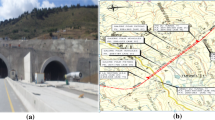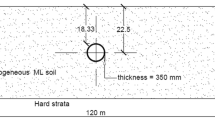Abstract
Tunnels are usually constructed in stratified geotechnical environments. However, most tunnel designers prefer to use a simplified model with the assumption of homogeneous soil conditions. This paper presents a numerical model of the semicircular tunnel in a stratified soil condition. In this study, the tunnel displacement and stresses are studied at critical points say top and bottom of tunnel geometry for geostatic and induced load condition as the tunnel is considered to be served for the single railway track. The study extended for different stratified sequence. This infers that the stresses are more at the bottom of the tunnel and propagate higher towards the bottom of stratification. But the observation is not the same for the settlement, and the weak settlement zones are created in the soil and values vary for different stratified sequences.
Access this chapter
Tax calculation will be finalised at checkout
Purchases are for personal use only
Similar content being viewed by others
References
Anagnostou, G., & Kovári, K. (1996). Face stability conditions with earth pressure balanced shields. Journal Tunnelling and Underground Space Technology, 11, 165–173.
Anagnostou, G., & Kovári, K. (1994). The face stability of slurry-shield driven tunnels. Journal Tunneling and Underground Space Technology, 9, 165–174.
Broere, W. (2015). On the face support of Microtunnelling TBMs. Journal Tunneling and Underground Space Technology., 46, 12–17.
Chen, R. P., Tang, L. J., Ling, D. S., & Chen, Y. M. (2011). Face stability analysis of shallow shield tunnels in dry sandy ground using the discrete element method. Journal Computers and Geotechnics., 38, 187–195.
Graziani, A., Capata, A., & Romualdi, P. (2007). Analysis of Rock-TBM-lining interaction in squeezing rock. Felsbau Magazine, 25, 23–31.
Hasanpour, R. (2014). Advance numerical simulation of tunneling by using a double shield TBM. Journal Computers and Geotechnics, 57, 37–52.
Khezri, N., Mohamad, H., & Fatahi, B. (2016). Stability assessment of tunnel face in a layered soil using upper bound theorem of limit analysis. Geomechanics and Engineering, 11, 471–492.
Lee, I. M., Lee, J. S., & Nam, S. W. (2004). Effect of seepage force on tunnel face stability reinforced with multi-step pipe grouting. Journal Tunneling and Underground Space Technology, 19, 551–565.
Liu, H. L., Li, P., & Liu, J. Y. (2004). Numerical investigation of underlying tunnel heave during a new tunnel construction. Journal Tunnelling and Underground Space Technology, 26, 276–283.
Leca, E., Leblais, Y., & Kuhnhenn K. (2000). Underground works in soils and soft rock tunneling. In International Conference on GeoEng2000. Melbourne, Key note lecture.
Mair, R. J., & Taylor, R. N. (1997). Bored tunnelling in the urban environment: State of the art report. In Proceedings of 14th ICSMFE, Hamburg. Balkema.
Mair, R. J., Taylor, R. N., & Burland, J. B. (1996). Prediction of ground movements and assessment of risk of building damage due to bored tunneling. In: International Conference Geotechnical Aspects of Underground Construction in Soft Ground (pp. 713–718). London, Balkema).
Mestat, Ph, Bourgeois, E., & Riou, Y. (2004). Numerical modelling of embankments and underground works. Computers and Geotechnics, 31, 227–236.
Peck, R. B., Hendron, A. J., Mohraz, B. (1972). State of the art in soft ground tunneling. In The Proceedings of the Rapid Excavation and Tunneling Conference (pp. 259–286). New York, NY: American Institute of Mining, Metallurgical, and Petroleum Engineers.
Zhang, Z. X., Hu, X. Y., & Scott, K. D. (2011). Discrete numerical approach for modeling face stability in slurry shield tunnelling in soft soils. Computers and Geotechnics, 38, 94–104.
Zhang, C. P., Han, K. H., & Zhang, D. L. (2015). Face stability analysis of shallow circular tunnels in cohesive–frictional soils. Tunnelling and Underground Space Technology, 50, 345–357.
Author information
Authors and Affiliations
Corresponding author
Editor information
Editors and Affiliations
Rights and permissions
Copyright information
© 2020 Springer Nature Singapore Pte Ltd.
About this paper
Cite this paper
Badry, P., Venkateshwarlu, M., Sai Kiran Reddy, D., Prasad, V., Vishal Preetham, M. (2020). Numerical Analysis of Single Track Railway Tunnel in a Stratified Soil Condition. In: Saride, S., Umashankar, B., Avirneni, D. (eds) Advances in Geotechnical and Transportation Engineering . Lecture Notes in Civil Engineering, vol 71. Springer, Singapore. https://doi.org/10.1007/978-981-15-3662-5_26
Download citation
DOI: https://doi.org/10.1007/978-981-15-3662-5_26
Published:
Publisher Name: Springer, Singapore
Print ISBN: 978-981-15-3661-8
Online ISBN: 978-981-15-3662-5
eBook Packages: EngineeringEngineering (R0)




